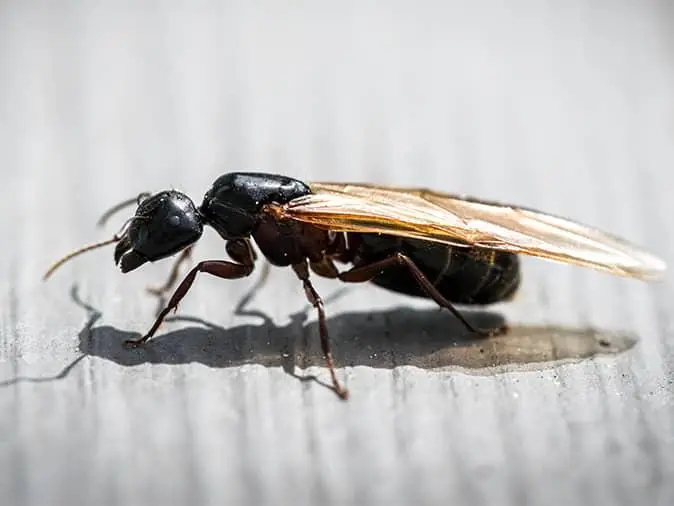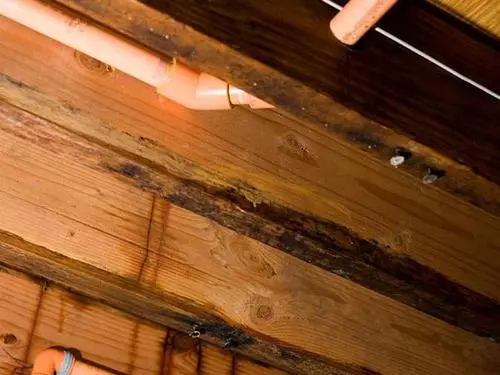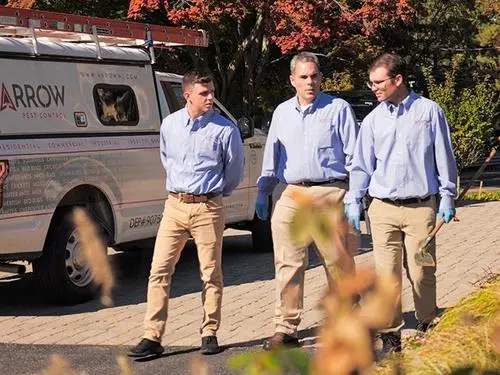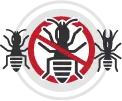Flying ants could be a sign of a serious pest problem
If you notice the presence of flying ants in or around your home, you’re probably alarmed and even a bit curious about what they are and the potential risks they pose. While these insects can indeed be intriguing, they also serve as an important warning sign that your home is potentially being targeted by wood-destroying carpenter ants.
Not all winged ants are carpenter ants
Almost all ant species swarm to establish new colonies once their existing ant colony matures and reaches its maximum population. When that occurs, it will send out reproductives (i.e., flying ants) to start new nests.
While it’s true not all winged ants in New Jersey are carpenter ants, if you see big, winged, black or reddish colored ants flying or crawling around your windows or elsewhere in or around your home, you should take heed. Seeing flying carpenter ants means that there is a mature nest nearby, and it could be in your home. It’s also entirely possible those winged insects are termite swarmers.

When should I be worried about carpenter ants?
Since flying ants only appear briefly, before disappearing to begin new nests, here are a few other signs you can keep an eye out for to know if you have these wood-damaging ants in your home.
- Sightings of carpenter ants: If you see a single large ant wandering around in your home, this may be a carpenter ant scout. They’re usually black or dark brown but may also be a combination of black and reddish-brown. They’re also the largest type of ant you will see inside your New Jersey home, measuring typically around 1/4 to 1/2 inch in size. If it is a carpenter ant, and if you have good eyesight, you should see a single node between the ant’s thorax and its abdomen.
- Winged ants (swarmers): As we mentioned above, winged ants are the reproductive members of ant colonies. They only appear during certain times of the year, typically spring in our region, and may exceed ¾ inch in size.
- Ant trails: Carpenter ants tend to establish trails or paths as they move around. You may notice lines of ants traveling in a distinct path to and from a food source or nesting area. It’s important to note, that you won’t always see a long line of marching ants, it could be a carpenter ant here or one there.
- Dead ants: If carpenter ants have taken up residence, it’s not uncommon to find dead ants indoors, especially near windows, doors, or other entry points.
- Frass and wood shavings: If you see piles of wood shavings underneath wooden items, this can be a sign of carpenter ants. These ants do not eat wood the way termites do, so they need to remove the wood they chew. They will push the shavings out of “kickout holes” after chewing tunnels and galleries. But keep in mind that often this “frass” is kicked out in places that are hidden, such as inside wall voids or in crawl spaces.
- Noises in the walls: If you hear faint rustling noises inside woodwork or walls, this may be carpenter ants hard at work destroying creating tunnels and nests and ultimately damaging your home.

Moisture problems may be the cause of your carpenter ant problem
While this article is about flying ants, it’s important to call out the connection between moisture problems and carpenter ant infestations. You see, carpenter ants are attracted to damp and moist areas, as these conditions make it easier for them to tunnel through wood. If your home is experiencing water leaks, moisture problems, or if there is water damaged wood inside, there’s a very good chance these pests will find it and take advantage of the situation.
How to tell if your New Jersey home has carpenter ant damage
If you’ve discovered flying ants in your home and are worried about carpenter ant damage, here are some signs to look out for:
- Wood damage: Check wooden structures, such as beams, windowsills, and door frames, for signs of damage. Carpenter ants create smooth, clean tunnels through the wood that run with or against the grain. This is noteworthy because it distinguishes them from termite tunnels which are lined with mud-like material and always run in the same direction as the grain.
- Malfunctioning doors & windows: Doors may begin to stick or not close properly if carpenter ant damage is severe enough. Likewise, carpenter ant damage may cause windows to become more and more difficult to open and close.
- Warping walls, floors, and ceilings: Walls may begin to bulge, floors may begin to sag, and ceilings may start to warp if carpenter ant damage is severe enough.
- Damaged insulation: Carpenter ants nest in insulation as well. If you find attic insulation that appears damaged or that is collecting moisture, it might be caused by an infestation of these wood-destroying pests.
How to get rid of carpenter ants in New Jersey
To avoid flying ants in or around your home and to stop carpenter ants from infesting your structure, we recommend the following prevention tips:
- Seal all potential entry points: Examine the outside walls and foundation of your home and seal up any gaps or cracks you can find. Look carefully around electrical conduit, pipes, air conditioners and anything else that enters your home. Don’t forget to check your roof area as well.
- Remove food sources: Open garbage, pet food bowls, barbecue leftovers, etc., are all very attractive to carpenter ants and other household pests.
- Eliminate water sources: Leaky pipes, faucets, and other indoor plumbing issues as well as clogged gutters, standing water, and other water sources outside should be fixed or addressed to discourage carpenter ant activity.
- Keep vegetation trimmed back away from your home: Tree limbs, shrubs, and other landscape elements often act as bridges to a home. If you cut them back so that nothing touches the exterior of your house, you’ll make it harder for carpenter ants and other pests to get inside.

Why professional carpenter ant control in New Jersey is the smart choice
We understand the desire to take care of your own pest problems but DIY carpenter ant treatments often fail because the wrong products are used in the wrong areas or the homeowner cannot locate the nest. If the nest is not exterminated, you can count on a re-infestation. The best way to get rid of carpenter ants is to contact a licensed exterminator.
Here at Arrow Pest Control, we offer effective carpenter ant control in Saddle River, Summit, and Westfield as well as communities throughout our multi-county service area. If you’ve found spotted flying ants, have uncovered carpenter ant damage, or have noticed other signs of a carpenter ant problem, contact our locally owned and family-operated company pest control company right away!
Sign up for Arrow’s Home Protection Program Plus for pest treatments that keep carpenter ants & other pests away all year-round!
Home Protection Program Plus
This program includes everything from the Home Protection Program – PLUS carpenter ant control and our termite monitoring advantage. Arrow will install a passive subterranean termite monitoring system at critical or conducive areas along the exterior perimeter foundation of your home. This system will include up to 4 in-ground subterranean termite monitoring stations. These stations will be serviced and inspected as part of your routine service.
Should the monitors indicate termite activity or termites occur within the home, Arrow will provide you with a termite treatment proposal at a 50% discounted rate, and you will be upgraded to Arrow Premier at the current prevailing rate.
- Is a year-round program that provides full interior and exterior service.
- Service includes a one-time interior service per year and two exterior treatments.
- Covers your entire property* including the attic, mailbox, playset, shed, and fence.
- Termite monitoring advantage
Pests targeted with Arrow’s Home Protection Program Plus includes all the pests included in the Home Protection Program PLUS carpenter ants, pharaoh ants, and acrobat ants.
*If you have a pool house that requires service, pricing would increase based upon the size of the structure.
*Termite monitoring advantage is not applicable in over-55 communities

Free Home Estimate
"*" indicates required fields

